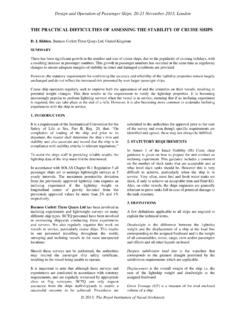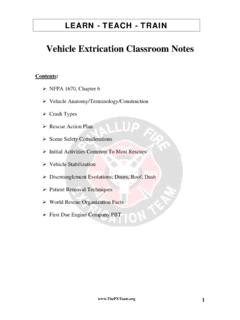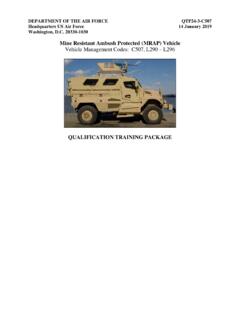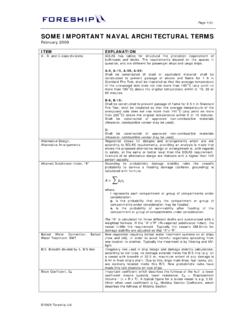Transcription of Probabilistic versus Deterministic Damage Stability …
1 ProbabilisticversusDeterministic Damage StabilityJonathan StrachanBurness Corlett Three QuaysThe Maritime ConsultantsIntroduction Deterministic Requirements Probabilistic Requirements 120m Yacht Project passenger Ship Deterministic Two Compartment Probabilistic Analysis >160m Yacht Project passenger Ship Deterministic Two Compartment Probabilistic Analysis Conclusion Suggested MethodologyDeterministic Damage passenger Yacht Code uses Two Compartment enhanced criteria Damage Extent Damage Length 3%L +3m Transverse Extent to B/5 Vertical Extent Upwards without limits Lesser Extents Criteria Margin Line* Stability Criteria Requirements for Range and Area of GZ curve Heeling moments applied Pax Crowding Lifeboat / Liferaft Launching Wind Pressure Attained indexA >=Required indexR Required index R function of - Length, Number of persons andwhether lifeboats are fitted Attained index AA= Pi (Vi.)
2 Si) Pi is a function of the arrangement of transverse bulkheads andlongitudinal bulkheads Vi factor : probability that a watertight deck above the waterlineremains intactProbabilistic DamagePiprobabilitycompartment (s)damagedSiprobability shipsurvives Damage tocompartment (s)Notes on Probabilistic Damage No longer any reference to One or Two compartment standard Transverse extent is to B/2 from shell, therefore Damage can extendpast the Centreline Services are no longer protected by B/5 No Margin Line requirement No rules for subdividing the vessel All survived damages (under max Damage length) can contribute tothe Attained index Bearing in mind the above: Probabilistic analysis changes theconcept of optimum bulkhead arrangementsCompartment DefinitionSimplest Compartment Definition Fire Zone Bulkhead Collision BulkheadIllustrates Possible single zone damages Possible multiple zone damagesLsLs13254 Compartment DefinitionSingle Compartment DamageTo Zone 213254 Compartment DefinitionTwo Compartment DamageIllustrated by Red Parallelogram132541&2 Compartment Definition Full Compartment Definition All Watertight Bulkheads High SurvivabilitySurvival Criteria Probability of Survival Si Calculated for each Damage Case Si = min( S intermediate, i or S final, i x S mom, i)
3 Where S intermediate and final are a function of GZ Max and Range Important These criteria represent the probability of survivalSurvival of SurvivalRange (Deg)Probability of Survival in the Intermediate Max Not a step function like Deterministic analysisOther CriteriaSi (Prob of Survival) is taken as zero if the following are immersed inthefinalstage of Damage : Hatches, Doors, Air Pipes ventilation openings Horizontal escape routes on the Bulkhead deckSi (Prob of Survival) is taken as zero if the following are immersed intheintermediate or finalstage of Damage : Vertical escape hatch Control station for operation of WT doors Piping or ventilation that causes progressive floodingVertical Escape HatchesVertical Escape Hatches (S=0)Horizontal EscapesHorizontal EscapesHorizontal EscapesHorizontal Escapes (S=0)Comparison of MethodsBased on Two Case Studies: 120m Project designed to Two compartment standard >160m Project designed to Two compartment standard BCTQ compared Probabilistic Calculation resultsProbabilistic Calculation BCTQ have developed a Probabilistic Module for in-house NavalArchitecture Software HYDAS Software calculates.
4 Probability of Damage Pi Probability of Survival Si A= Pi Si is then calculated for each draft condition:Subdivision DraftPartial DraftLight DraftAttained indexA= As+ + , Ap and Al >= varyKGand rerun tillA >= RAdditional Calculations Minor Damages Deterministic analysis to a One compartment standard Damage length between and 3%L Transverse extent is between B/10 and B/20 Si >= the 3 draft conditions Double bottom Required to extend throughout ship, otherwise additionalcalculations are required S= Yacht ProjectDeterministic AnalysisTwo compartment standard11 watertight compartmentsTotal 550 Damage : Guests65 CrewDesigned in 2008 with MES instead ofLifeboatsDesigned to passenger Shiprequirements of SOLAS 1990120m Yacht Project - ProbabilisticCompartments in DB included in analysis18 Damage ZonesCalculation undertaken with up to 5 ZonesTotal 1776 Damage CasesR= A= Yacht Project Results Loading conditions comply withboth Probabilistic and TwoCompartment standard Two compartment standard ismore onerous Probabilistic analysis requires1776 Damage cases Deterministic analysis requires550 Damage casesSimplified Compartment ArrangementIncludes.
5 Watertight Bulkheads Double Bottom defined Horizontal escapes defined Vertical Escapes No tanks Yacht divided into 12 zones3 zone damages Reasonable correlation with fullresults 430 Damage casesReduced analysis time Allows optimisation of bulkheadarrangementTender Garage Example Tender garage increased by to take a 12m Tender For this example the motor room increased in sizeResults Probabilistic results unchanged Two Compartment results severelyeffected by modificationConclude that:- Probabilistic is less rigid in thepositioning of bulkheadsTender Garage Example>160m Yacht ProjectDesigned with LifeboatsDesigned to Deterministic PassengerShip requirements of SOLAS 1990 Two compartment standard14 watertight compartmentsBeam.
6 24 Guests126 CrewDesigned in 2006>160m Yacht Project Probabilistic Same WatertightCompartments DB compartmentincluded More Zones Damage to B/2 4677 Damage Cases>160m Yacht Analysis ResultsConclusion Probabilistic analysis More work More flexible bulkhead arrangement The 2 Yachts designed as Two compartment standard comply withprobabilistic requirements Margin line replaced by WT hatches, horizontal escape routes on bulkheaddeck There is a benefit of locating these on CL Damages assumed to occur up to B/2, therefore more systems will requirebulkhead valves Simplification of Compartment Arrangement Reasonable step in Initial AnalysisInitial Probabilistic Analysis - MethodologySix Steps1.
7 Undertake Two compartment Deterministic analysis if required2. Define loading conditions Draft, Trim and KG3. Use a simplified compartment arrangement Locate Collision bulkhead Locate Fire Zone bulkheads Locate Engine Room and other bulkheads Insert Double Bottom Define Horizontal and Vertical escapes routes4. Optimise and once working arrangement is found5. Arrange tanks, including cross flooding6. Analyse to include minor damages and double bottom damagesThank You.





